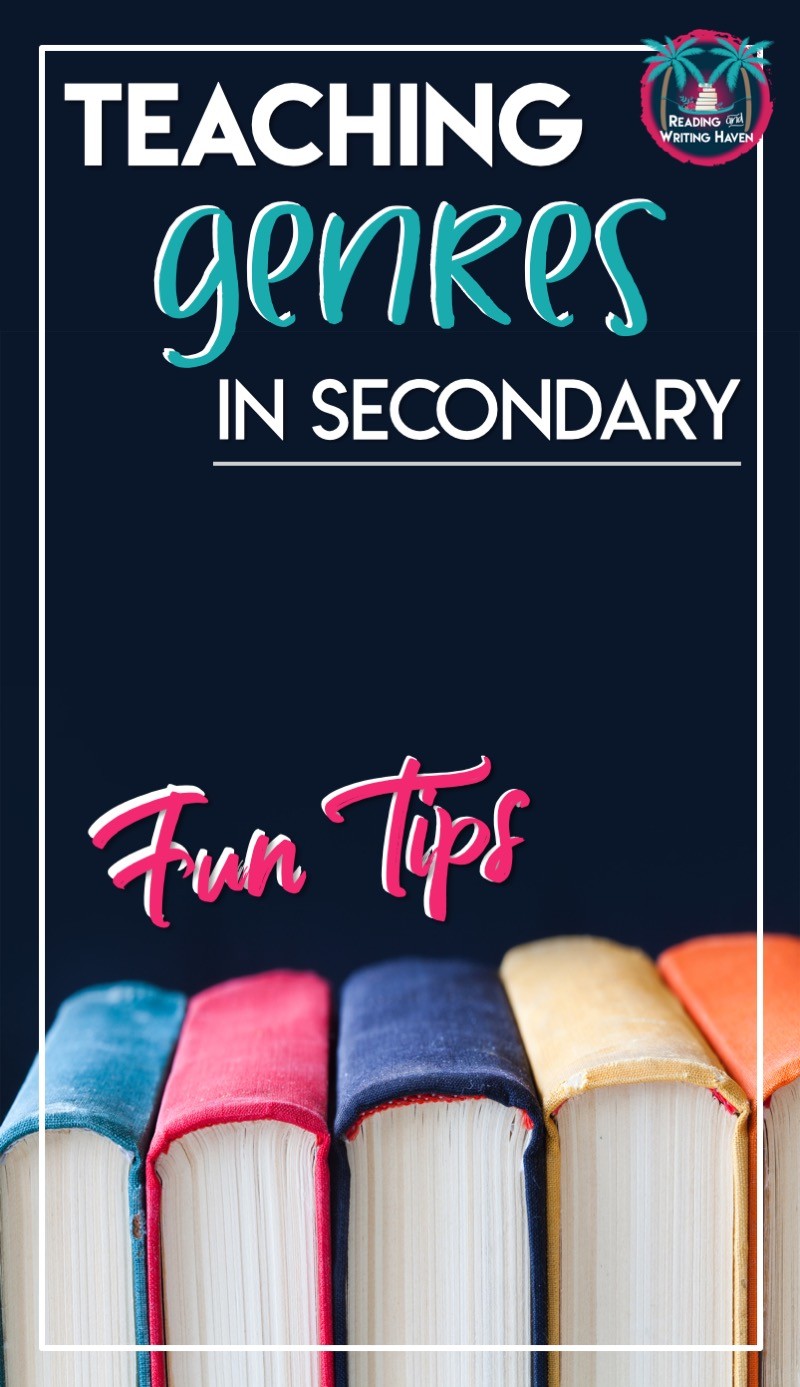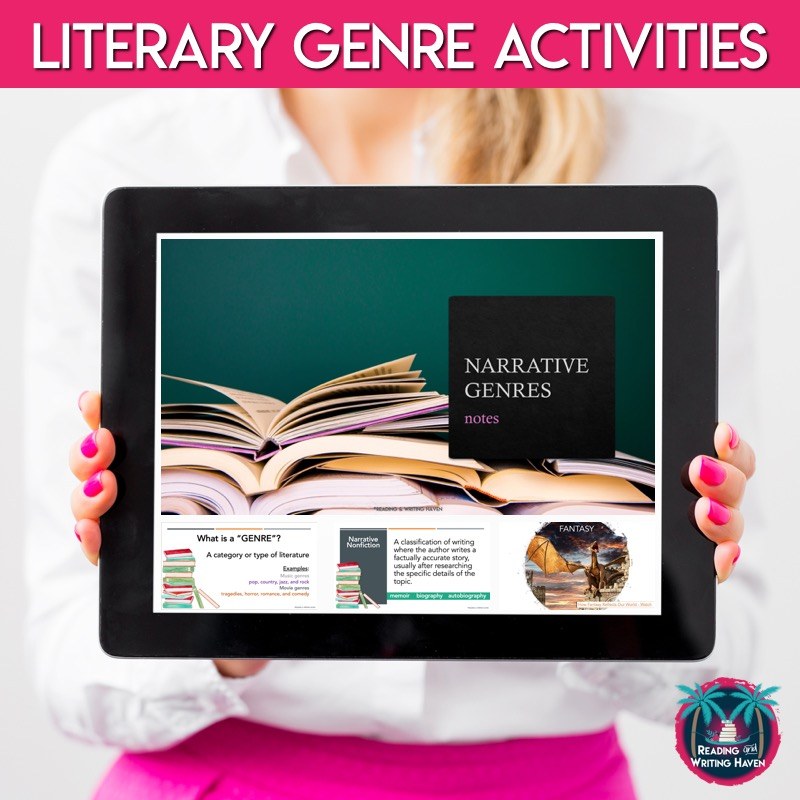Teaching Literary Genres: Lesson Planning Ideas
The actual word “genre” is rarely referred to in the Common Core Standards. Even so, explicitly teaching literary genres is beneficial at all grade levels. Unfortunately, many high school curriculums omit genre instruction for various reasons…time constrains, overlap of curriculum with middle school, the seemingly elementary nature of the content, etcetera.
WHY TEACH LITERARY GENRES?
Repetition.
Even though students are introduced to the concept of genres very early in school, my high school students usually don’t remember them.
For instance, as a part of my culminating study for my Reading degree, I organized a genre unit. At the outset of this unit, a pre-test revealed that the vast majority of my ninth graders couldn’t tell me the difference between realistic fiction and historical, between science fiction and fantasy, between a myth and a legend, or between narrative nonfiction and informational texts.
Just like with grammar, writing skills, and reading comprehension, a genre study is not something that can be mastered when taught in isolation during the course of one grade level’s ELA curriculum.
Bridging Literacies.
Explicitly teaching students to recognize specific genres helps to bridge the gap between literacies students see at home and at school.
At home, students are not necessarily exposed to the same types of texts as they are at school. For example, in many homes, students are more likely to be exposed to game-based texts, letters, e-mails, and picture books.
At school, students might interact with academic-style texts, including short stories, novels, textbooks, and articles. Educators can bridge the literacy gap between home and school by validating the texts they see at home and teaching students to analyze all genres of literature…even a grocery list, a recipe, or a coupon!
Active Reading.
Teaching literary genres helps students to be active readers.
For example, if I told you that we were going to read a text called “The Superbowl Dolphin,” it would be challenging for you to make predictions about it without understanding that it’s an article and that an article is a nonfiction text. Upon hearing this title, many of my own freshmen who at the beginning of the year cannot define “article” for me would assume we were about to read a fictional story. As a result, their predictions would be uneducated, and monitoring them would be hard, as would be comprehension in general.
If we want students to be active readers who engage with the text in meaningful ways, we need to give them the tools to understand what type of text they will be reading.
Analysis.
Examining text features and content to determine genre is an avenue of teaching students to analyze a text. Analysis is written all over the Common Core Standards and is an increasingly important skill in 21st Century teaching.
Appreciation.
Many students don’t appreciate a text because they don’t understand the characteristics of the genre(s) in which it fits. For example, when I teach my students about the story of The Odyssey, we spend a considerable amount of time learning about myths and legends. I haven’t always done this.
When I first taught the epic poem, I just told students, This is a myth. My inexperience with teaching high school students told me that ninth graders should understand what that means. But many of them didn’t. As a result, they were confused about sea monsters like Scylla and Charybdis. Are they real? Do people actually believe this stuff? This is so weird. Obviously, they didn’t have an understanding that myths are written to explain something, that they represent beliefs of a culture, and that they often involve supernatural elements.
Teaching students not only what genres exist but also teaching them to analyze texts to determine their genre ultimately puts them in a position to appreciate the literature they are reading.
Recognition.
Ultimately, we want our students to be more educated when confronting texts in real life. If we teach them to identify, analyze, and recognize various genres in school, they will be more prepared to do so on their own outside of the classroom.
As the book whisperer, Donalyn Miller, writes, “As part of their education as readers, it is necessary for students to learn the common language that readers speak when discussing and investigating books. I frame instruction and discussions all year long around genre, the formal categorization of books” (p. 88).
Navigation.
If students understand the genre they are reading, they can, in turn, better navigate and utilize the text features. This concept can and should be taught in ALL classes, not just ELA.
Students should be familiarized with the genres they will encounter in a course, and teachers should give explicit instruction regarding familiar text features that accompany that genre. Textbooks? Magazine articles? Periodicals? Each has unique and important text features that will aid the intended audience in fully comprehending the passage.
Writing Benefits.
It should come as no surprise that teaching genres improves a student’s confidence when it comes to responding to prompts. Genres of writing are not much different than those of reading. We ask students to write expository, narrative, argumentative, and analytical pieces, for example. If students understand and can analyze different genres when they read them, they will better be able to approach these prompts from an author’s standpoint.
HOW TO TEACH LITERARY GENRES?
If you’re looking for practical approaches for teaching literary genres, here are some avenues I’ve found successful.
First, determine the terminology.
The best approach is to begin by determining the terms you want to cover.
You can use a pre-test to identify misconceptions and areas of weakness, but I enjoy having a discussion with students while they take introductory notes on the genres we will explore. During the discussion, I ask them to give examples of their favorite books, stories, and movies that fall into each category and to explain the characteristics of the work that allow it to be classified as such. Through this discussion, I’m able to decide which genres students have already mastered, which they are developing an understanding about, and which we need to study more closely.
When choosing genres, consider the grade level and ability level of your students. Freshmen might need to begin with the basics, like historical fiction, narrative nonfiction, and dystopian literature, but advanced juniors and seniors could study eras of literature, like Romanticism, Victorian, and Renaissance.
Then, select a format.
Next you’ll want to select an approach (or multiple approaches) for how you want to address the terms. Do you want to cover the genres in one unit? Would it work better if you covered them over the span of the year? What vehicle will you use?
Some ideal options include reader’s workshop, literature circles, independent reading programs, book clubs, multi-genre projects, bell ringers, and mini lessons paired with texts already embedded in the curriculum.
No matter the format, I have experienced success by beginning with direct instruction and following with whole class identification and analysis, which slowly progresses to similar small group activities, and finally individual mastery.
Finally, decide upon practice approaches.
It’s feasible to talk about and analyze genre with every single text we read. (Romeo and Juliet? Romantic tragedy. Play. The Odyssey? Epic Poem. Myth. To Kill a Mockingbird? Classic. Historical Fiction. Coming-of-Age. Scholastic Scope? Magazine. Nonfiction. Informational text.) Even so, discussion about course texts is not the only vehicle to allow students to teach literary genres. Here are a few ideas to make practice engaging when teaching literary genres:
1. Play 3 Truths and a Lie.
Have each student write 4 statements about genres on a piece of paper, three being truths, and one being a lie. (For example: 1) Realistic fiction could actually happen, but it hasn’t. 2) Fantasy involves science and technology. 3) Dystopian novels generally involve themes of oppression. 4) Informational texts fall under the umbrella category of nonfiction.) After students have written their genre statements, you can collect them and use them as station activities, compile them as a class exercise, use them for discussions, have students pass them around the room one person at a time, etcetera. The goal would be to identify which statement is the lie.
2. Have a book sorting contest.
Work with the school librarian to collect an interesting assortment of novels (this is a simple way to get students interested in a book without letting them know your ulterior motive). Group the novels into sets of 10 books. As students work with a partner to sort the stack of novels into categories, time them (1 or 2 minutes is plenty of time). The goal is to ask students to use the information on the book cover, the back of the book, and the book sleeves to determine its genre.
3. Host a genre walk.
At the outset of an independent reading unit, I like to take students to the library so they can familiarize themselves with the layout, with the location of books, and with the book check-out and return procedures. After the librarian gives them a tour, I give them a piece of paper that has several main genres listed. I ask them to peruse the shelves and look for a book they might be interested in reading that would fall into each category.
4. Set them up on a blind date.
Remove the title and author from a text. You can use a few paragraphs from a short story, an excerpt from a novel, or a portion of a nonfiction text. Tell students you want them to get to know this excerpt, as if they were trying to learn about a potential girlfriend or boyfriend (it’s just a fun analogy…you can leave this part out if you prefer). This practice activity encourages students to analyze the information available in the excerpt to determine possible genres that would apply. When selecting excerpts, make sure to choose texts that have obvious traits of a particular literary genre (ex. – aliens, fairies, morals, etc.).
5. Incorporate visual texts.
My students love it when I use visual texts. They are an integral part of our modern society, and they have value. One time, I showed students clips of “horror” movies (school appropriate, of course). We analyzed the films for trends. What did scary movies from the 80s have in common versus scary movies from the 2010s? Why might horror movies have evolved? How have audiences changed? The students LOVED this discussion.
Teaching literary genres is an integral part of an ELA curriculum for all grades…middle and high school included. How do you approach genre instruction in your secondary classroom? We want to hear from you!
READ NEXT
Balancing Independent Reading with Whole-Class Novels
7 Post-Reading Activities
6 Ways to Assess Comprehension without Making Students Hate Reading
RELATED RESOURCE:
This resource contains some of engaging activities and mini lessons I use when teaching literary genres.


